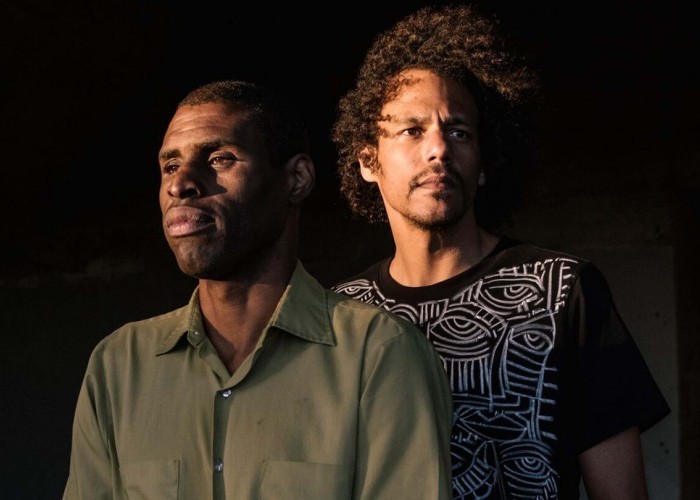Oct 28, 2025 10:47 AM
In Memoriam: Jack DeJohnette, 1942–2025
Jack DeJohnette, a bold and resourceful drummer and NEA Jazz Master who forged a unique vocabulary on the kit over his…

Marshall Trammell (left) and Zachary Watkins are set to release Black Access/Black Axes (Sige), an album that will be Black Spirituals last recording with its current personnel.
(Photo: Mark Mahaney)What was the process for making the album?
ZW: We are ultimately improvisers. I tune my axe to harmonic intervals. I have lived with this specific just intonation now for over five years and now tune by ear. I have developed modular patterns through improvisation, listening and feeling. Concerning form, I am interested in radical diversity. High highs, low lows, and everything in between. I especially enjoy the rich range of energy between Marshall and I.
MT: The album is a collection of recordings and relationships with sound engineers and music studios: sound engineer/music producer Randall Dunn, the miraculously talented Eyvind Kang, the iconic, pre-doom band Earth.
These relationships led Black Spirituals to touring with Earth in 2014, hanging out with the guys from Sunn O))) and two Northwest performances with the incomparable Jessika Kenney and Eyvind Kang, and experimental musician Daniel Menche.
My percussion techniques, successful or not, have developed into what I refer to as “warrior ethos.” It is about intention, but also the use or reuse or references to African Diasporic and other techniques that have traveled from West Africa, for example, to the so-called “New World” and into my personal arsenal for deployment in the Bay Area or upstate New York.
What’s your take on the free jazz and experimental music community in the Bay today?
MT: In the Bay Area, there remain only a few—well two I can think of—musicians’ organizations that developed into institutions of cultural resistance and political consciousness in the free jazz/experimental music community: Cultural Odyssey and Asian Improv Arts. Cultural Odyssey features Rhodessa Jones and Idris Ackamoor; Asian Improv Arts features such artists as Francis Wong, Jon Jang, Fred Ho and many other culture-bearers/cultural activists.
ZW: Through my collaborative work with AFFIRMATIVE ACTION, I seek to confront the normative white new-music establishment. Nonetheless, the “scene” is complex. Many new artists are inspired.
How did the Bay’s music community define your early work? Did it influence this album?
MT: The mysteries of Glenn Spearman’s Double Trio and ROVA Saxophone Quartet’s use of self-directed conduction, extemporaneous musical notation and sheer, idiosyncratic inventiveness on their instruments gave me insight—back in 1993—into the world of obsession and dedication. At that time, I was at San Francisco State University for creative writing, and I was a squatter during some very rainy months. I cannot say that any of that ended up on the album, but that work is part of a much larger continuum that I count myself lucky enough to be included in.
SW: We cut our teeth at many underground venues. Many have shut down after the tragic Ghost Ship venue fire. Marshall and I played many shows here in the Bay and were given wonderful opportunities—the Matatu Festival, performing alongside Saul William, the Resonance Series at the Exploratorium Kanbar Center, where we engaged over 100 speakers and opening for the Sun Ra Arkestra.
What do you want listeners to remember about the music?
MT: People might remember that negro spirituals are/were codes for emancipation from oppressive forces and that those codes were a call to action in an abolitionist enterprise relevant to conditions in everyday life today and 200 years ago.
ZW: New black music: inventive and ultimately emancipatory. DB

Jack DeJohnette boasted a musical resume that was as long as it was fearsome.
Oct 28, 2025 10:47 AM
Jack DeJohnette, a bold and resourceful drummer and NEA Jazz Master who forged a unique vocabulary on the kit over his…

Goodwin was one of the most acclaimed, successful and influential jazz musicians of his generation.
Dec 9, 2025 12:28 PM
Gordon Goodwin, an award-winning saxophonist, pianist, bandleader, composer and arranger, died Dec. 8 in Los Angeles.…

D’Angelo achieved commercial and critical success experimenting with a fusion of jazz, funk, soul, R&B and hip-hop.
Oct 14, 2025 1:47 PM
D’Angelo, a Grammy-winning R&B and neo-soul singer, guitarist and pianist who exerted a profound influence on 21st…

Flea has returned to his first instrument — the trumpet — and assembled a dream band of jazz musicians to record a new album.
Dec 2, 2025 2:01 AM
After a nearly five-decade career as one of his generation’s defining rock bassists, Flea has returned to his first…

To see the complete list of nominations for the 2026 Grammy Awards, go to grammy.com.
Nov 11, 2025 12:35 PM
The nominations for the 2026 Grammy Awards are in, with plenty to smile about for the worlds of jazz, blues and beyond.…





